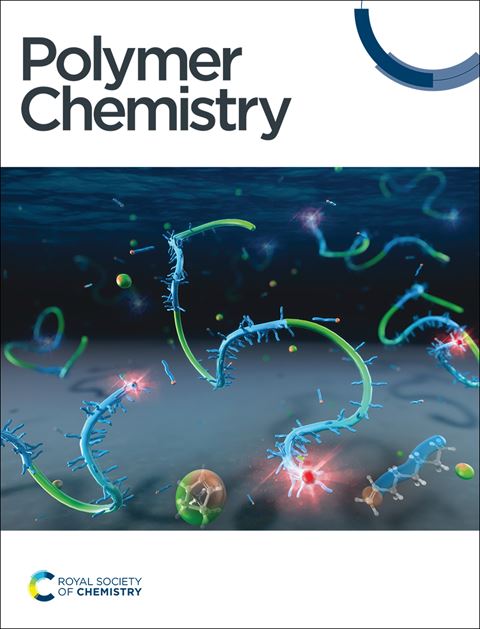Synthesis of butadiene-derived polyolefin graft copolymers and their crystallization behaviors†
IF 3.9
2区 化学
Q2 POLYMER SCIENCE
引用次数: 0
Abstract
The ability to synthesize polyolefin-based copolymers with controlled chemical composition and chain microstructure provides great opportunities for their use in compatibilizing polyolefin blends, particularly including polyethylene (PE) and polypropylene (PP), to address their waste recycling challenges. In this study, polyolefin graft copolymers comprising semicrystalline PE side chain and amorphous polyethylethylene (PEE) backbone were synthesized by grafting amine-terminated 1,4-polybutadiene (PB) onto carboxyl-grafted 1,2-PB, followed by hydrogenation. A suite of characterization techniques were employed to assess the degree of functionalization, polymer microstructure, and molecular weight of these graft copolymers containing different side chain lengths and graft densities. Moreover, since most commodity polyolefins are semicrystalline, understanding the crystallization behavior of these polyolefin copolymers is important. Specifically, the non-isothermal crystallization behavior of these graft copolymers was investigated using differential scanning calorimetry (DSC) and the Jeziorny-modified Avrami model. Both the graft copolymers and their homopolymer grafts exhibited heterogeneous nucleation with predominantly one-dimensional crystal growth and similar overall crystallization rates. However, PEE-g-PE10k and PEE-g-PE5k showed opposite trends in activation energy, likely due to a competition between nucleation facilitation and crystal growth restriction introduced by the graft structure. A preliminary investigation indicates that the incorporation of these graft copolymers into mixed PE : PP (50 : 50) blends can lead to improved mechanical performance. This study reveals the impact of graft architecture on the crystallization behavior of polyolefin-based blend compatibilizers.
丁二烯衍生聚烯烃接枝共聚物的合成及其结晶行为
合成具有可控化学成分和链结构的聚烯烃基共聚物的能力,为其在聚烯烃共混物(特别是聚乙烯(PE)和聚丙烯(PP))的增容化应用提供了巨大的机会,以解决其废物回收的挑战。本研究以端胺型的1,4-聚丁二烯(PB)接枝至羧基接枝的1,2-PB上,然后加氢,合成了由半晶PE侧链和非晶态聚乙烯(PEE)骨架组成的聚烯烃接枝共聚物。采用一系列表征技术来评估这些具有不同侧链长度和接枝密度的接枝共聚物的功能化程度、聚合物微观结构和分子量。此外,由于大多数商品聚烯烃是半结晶的,了解这些聚烯烃共聚物的结晶行为是很重要的。具体来说,利用差示扫描量热法(DSC)和Jeziorny-modified Avrami模型研究了这些接枝共聚物的非等温结晶行为。接枝共聚物及其均聚接枝均表现出非均相成核,以一维晶体生长为主,总体结晶速率相似。然而,PEE-g-PE10k和PEE-g-PE5k表现出相反的活化能趋势,这可能是由于接枝结构引入的成核促进和晶体生长限制之间的竞争。初步研究表明,将这些接枝共聚物掺入PE:PP(50:50)共混物中可以改善机械性能。本研究揭示了接枝结构对聚烯烃基共混增容剂结晶行为和动力学的影响。
本文章由计算机程序翻译,如有差异,请以英文原文为准。
求助全文
约1分钟内获得全文
求助全文
来源期刊

Polymer Chemistry
POLYMER SCIENCE-
CiteScore
8.60
自引率
8.70%
发文量
535
审稿时长
1.7 months
期刊介绍:
Polymer Chemistry welcomes submissions in all areas of polymer science that have a strong focus on macromolecular chemistry. Manuscripts may cover a broad range of fields, yet no direct application focus is required.
 求助内容:
求助内容: 应助结果提醒方式:
应助结果提醒方式:


